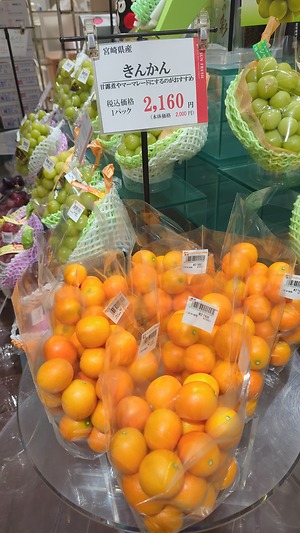


Kinkan Kumquats
Estimated Inventory, lb : 0
Description/Taste
Kinkans vary in appearance, depending on the variety, and generally average 2 to 4 centimeters in length with an oval to round shape. The fruit’s peel is semi-thin, smooth, taut, and glossy and is covered in visible oil glands. The peel also ranges in color from golden yellow to dark orange with red undertones and clings tightly to the tender, firm flesh. The pale yellow to orange flesh is moderately juicy and somewhat chewy, encasing anywhere from 1 to 6 cream-colored to green seeds. Kinkans release aromatic oils from the peel, creating a sweet, fruity, and bright fragrance, and the entire fruit is edible, including the rind, flesh, and seeds. The fruit’s peel is sweet, subtly floral, and fruity, balancing the tart, sour taste of the flesh, producing an intense sweet-tart combination with a zesty, citrus zing.
Seasons/Availability
Kinkans are available in the fall through winter.
Current Facts
Kinkan, botanically classified as Citrus japonica, is the Japanese term for kumquat, belonging to the Rutaceae family. There are several varieties of kumquats generally labeled as Kinkan in Japanese markets, and the fruits are sold fresh, utilized in raw and cooked preparations. Kinkans grow in clusters on evergreen trees that can reach up to 2 to 4 meters in height and are cold hardy, a common citrus planted in Japan as a landscape tree in home gardens. The term Kinkan is mainly used to describe round varieties of kumquats in Japan, also known as Marumi, Maru, Morgani, and Kinkit. There are also nagami or oval kumquats that are sometimes labeled as Kinkan, but this is less common.
Nutritional Value
Kinkans are an excellent source of fiber to regulate the digestive tract, vitamin A to maintain healthy organ functioning, and vitamin C to strengthen the immune system and reduce inflammation. The fruits also contain potassium to balance fluid levels within the body, calcium to protect bones and teeth, and provide lower amounts of iron, zinc, manganese, and copper. Inside the sweet peel, essential oils such as limonene and flavonoids offer antioxidant and anti-inflammatory properties. Kinkans are also used as a natural remedy for symptoms of colds and flu. The fruits are traditionally smashed, mixed with ginger, salt, and honey, and steeped as a soothing tea.
Applications
Kinkans have a sweet, tart, and tangy flavor well suited for raw and cooked preparations. The fruits can be consumed straight, out of hand, or sliced and tossed into green salads, fruit cups, and grain bowls. In Japan, some consumers solely eat the sweet peel of the citrus and discard the sour flesh. Kinkans can also be chopped into relishes and sauces, sliced and used as a fresh topping over ice cream, or layered over avocado toast for increased depth of flavor. It is important to note that the seeds in the flesh are edible and can be used as a natural source of pectin for jams and jellies. Kinkans can also be utilized in cooked preparations, diced into sauces, dressings, and glazes, or simmered into syrup as a bright flavoring. In desserts, Kinkans can be candied, baked into muffins, cakes, and pies, cooked into marmalade, jams, and chutney, or incorporated into tarts, ice cream, and yogurt. In mixology, the fruits are used as an edible garnish and can be infused into vodka for a citrus twist. The kumquats can also be sliced and stirred into champagne cocktails, fruit punches, or sparkling juices or placed as an edible garnish on the rim of the beverage. Kinkans pair well with meats such as poultry, lamb, and beef, seafood, fruits such as pineapple, cranberries, blood oranges, cherries, and kiwis, mint, honey, ginger, and nuts including almonds, pecans, and walnuts. Whole, unwashed Kinkans will keep up to seven days at room temperature. When stored in a sealed container in the refrigerator, the fruits will keep 1 to 2 weeks.
Ethnic/Cultural Info
On New Year’s Day, the Japanese have a tradition of resting, visiting family, and eating specific foods called “osechi ryori.” This tradition, which began during the Heian Period between 794 and 1185 CE, customarily included preserved foods that didn’t require cooking, like fish and vegetables simmered in soy sauce, vinegar, or sweet mirin. One of the sweeter preserved dishes was Kinkan kanro-ni or Japanese candied kumquats. The sweet-tart, chewy fruits were thought to bring good luck and prosperity in the year to come, and they were traditionally consumed out of hand or added as a garnish to cakes, bread, ice cream, tarts, or desserts like panna cotta. Throughout history, the preserved foods served during New Year festivities have changed due to cultural preferences, preparation time, and ingredient availability, but the tradition of cooking candied Kinkans has remained a favored holiday treat.
Geography/History
Kinkans, more generally known as kumquats, are native to Asia, specifically regions of China, and have been growing wild since ancient times. The fruits were first documented in China in the 12th century, grown for culinary, medicinal, and cultural uses, and were symbolically believed to bring good luck and prosperity when placed in households. Over time, Kinkans were introduced into Japan and other countries throughout Asia and were recorded as a commercially cultivated citrus in Japan by the early 18th century. Today the Miyazaki Prefecture on Kyushu Island is the top Kinkan-producing region in Japan. The prefecture is even known for its own branded Kinkan, labeled as Tama Tama, in markets. Miyazaki growers sell their fruits across Japan and export the tiny citruses to Hong Kong. Outside of the Miyazaki Prefecture, Kinkans are grown on a lesser scale in the Fukuoka and Kagoshima Prefectures. When in season, Kinkans can be found fresh at farmer’s markets, specialty grocers, and select supermarkets.
Recipe Ideas
Recipes that include Kinkan Kumquats. One

















